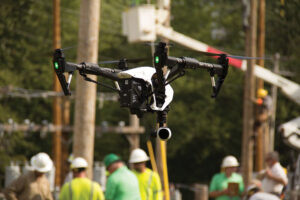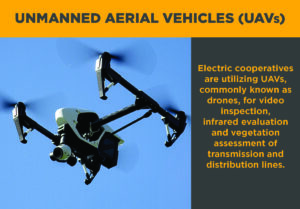Electric cooperatives and other utilities have a new tool to streamline maintenance and repair activities along the hundreds and thousands of miles of electric lines they service. While many power companies are just beginning to use unmanned aerial vehicles – more commonly known as drones – the potential for these systems is, well, sky high.
While the term drone can be applied to everything from self-guided military aircraft to $5 flying toys, drones for business, commercial and utility uses are aerial vehicles with cameras which are capable of flying and hovering several hundred feet in the air. The devices are controlled by an operator on the ground holding a remote control system similar to those used by radio-controlled car and airplane hobbyists. Many of the controllers include a video monitor and practically all systems utilize GPS technology to pinpoint locations.
“Drones have been used for several years in construction and agriculture,” says Dennis Watson, a faculty member in the Southern Illinois University College of Agricultural Sciences. Watson teaches a class on the use of drones.
“There are a lot of uses for unmanned aircraft,” he explains. “One example in agriculture is as an alternative to manually scouting crop.”
Watson adds the units are often used to inspect structures and roofs looking for storm damage by insurance adjusters and that there are countless uses in the building and engineering fields.
 “Utility companies are very interested in using them to fly over their lines to make inspections,” he says. “Consider that the rental of a helicopter can be thousands of dollars an hour. The purchase of a drone is a fraction of that. It’s a lot less expensive to send a technician out in a truck with a drone that they could just zip up into the air and take a look.”
“Utility companies are very interested in using them to fly over their lines to make inspections,” he says. “Consider that the rental of a helicopter can be thousands of dollars an hour. The purchase of a drone is a fraction of that. It’s a lot less expensive to send a technician out in a truck with a drone that they could just zip up into the air and take a look.”
Joe Priestley, director of technical services for Bloomington-based electric cooperative Corn Belt Energy, says that’s exactly the kind of thing his cooperative is doing. Priestley says the units are especially helpful when it comes to inspecting wooden utility poles for rot, something that traditionally has been done by sending a lineman up to the top of the pole.
“If you are looking at just one pole, it may take 10 or 15 minutes for a crew to do the work (in the traditional fashion of setting outriggers on a truck and sending a worker up in a bucket),” he explains. “With a drone, it may take five minutes to get everything pulled out, set up and to launch the drone to take photographs, so the difference in time is not that great. However, if you are looking at a series of six poles down the row, those five minutes turn into just eight or nine with the drone. For the truck, it’s going to be a lot more time because you have to reset at every pole.”
Another use of drones is in the maintenance of right-of-ways and areas beneath transmission lines, says Dan Gerard, chief technology officer for the Association of Illinois Electric Cooperatives.
“One of the most prominent uses would be inspecting the right-of-ways,” he says. “You can check those areas now, and then come back in a year or two and see how effective your tree trimming was and adjust accordingly.”
Gerard says drones can also be used to inspect substations for problem areas through the use of infrared cameras.
 “If we can run hotspot scans around substations and see inefficiencies based on a heat map, we can be proactive about replacing components before they fail, causing an outage,” he adds. “It all comes down to safety and efficiency. Instead of getting inside a substation, we can be outside of it and fly a drone, completing the job in a much more efficient and safe manner. The bottom line for co-ops is about efficiency and cost savings.”
“If we can run hotspot scans around substations and see inefficiencies based on a heat map, we can be proactive about replacing components before they fail, causing an outage,” he adds. “It all comes down to safety and efficiency. Instead of getting inside a substation, we can be outside of it and fly a drone, completing the job in a much more efficient and safe manner. The bottom line for co-ops is about efficiency and cost savings.”
According to Steve Quinn of Northbridge Professional Technologies located in Murphysboro, flying a drone requires a special license called a 107 from the Federal Aviation Administration.
“You have to be licensed to fly a drone commercially, which is defined as any flight that will benefit any commercial enterprise,” Quinn explains.
He says licensing requires prospective drone pilots to attend two days of FAA training and then pass a test on the restrictions and requirements for flying a drone, including regulations on when and where flight is permitted. He adds that when he took the class, most of the other students were from utility companies.
“Drones are becoming very useful tools for the industry,” he adds.
In fact, as construction progressed on a new facility for Egyptian Electric Cooperative Association, north of Murphysboro, Quinn regularly used his drone to provide aerial updates on the process.
“We shot aerial footage every few months, following the same path,” he recalls. “The cooperative would share it with everyone – their board members, team members, subscriber-members – and they were all very excited, and I think it showed them how drones could be useful.”
Gerard says he has even heard of a cooperative using a drone to pull a power line across a flooded waterway to replace one that was downed by a storm.
“It took half the manpower and was significantly safer than deploying a crew and a boat,” he notes, adding that he expects more and more creative uses for drones in the future. “I think there are uses out there that we haven’t even discovered yet.”
Gerard says that a school for remote pilot’s licensing for drones was recently conducted for cooperative employees, with another one in the planning stages. A drone flight school will be held in September for employees of member-cooperatives to assist them in learning to fly and utilize drones in their daily duties similar to what Priestley is doing for Corn Belt Energy. He adds with drones costing as little as $1,500 each, their widespread use is on the horizon. Priestley says possibilities are limitless.
“The innovation that’s happening, not only in equipment and its capabilities, but in the uses that people are coming up with, is amazing,” he says. “The biggest thing for me is the dream of where this could go in just a few years.”








